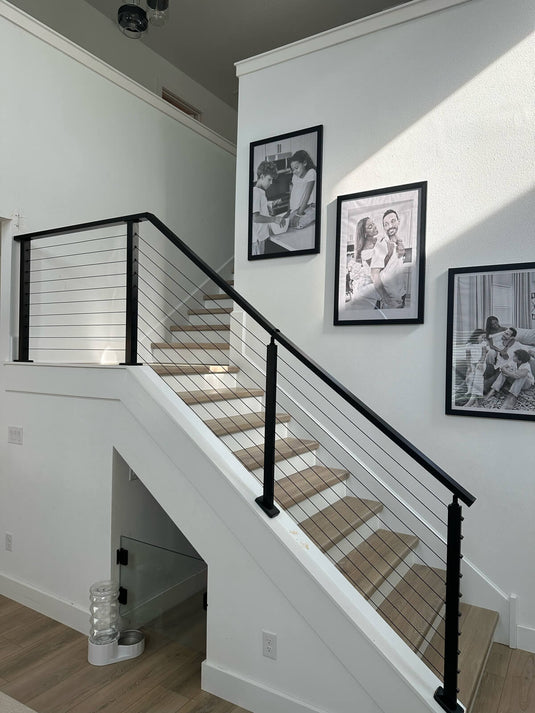TABLE OF CONTENTS
Are Floating Stairs Safe for Dogs?
Floating stairs infuse style and modernity into the home; however, to dog owners, one question usually crosses the mind: are these trendy staircases safe for four-legged pals? Can dogs handle the challenges that floating stairs uniquely present? In this article, we will discuss everything you need to know about floating stairs and how they fit into a home shared with pets. We would like to ensure that every nook and cranky corner of your living space is beautiful, friendly, and safe for all your family.

Floating Stairs and Your Dog's Mobility
● A Dog's Perspective
For dogs, navigating any kind of staircase requires coordination and confidence. When it comes to floating stairs, this can be particularly challenging. Smaller breeds or dogs with shorter legs may find it difficult to gauge the depth and distance due to the open space between each step. Similarly, older dogs or those with mobility issues may struggle more with floating stairs compared to conventional ones, as they rely heavily on seeing and feeling each step for safe footing.
● Breed-Specific Stair Challenges
It’s also worth considering that certain dog breeds have hereditary traits that can influence their stair-climbing abilities. For instance, long-bodied and short-legged dogs like Dachshunds may have a harder time balancing on the narrower treads often seen in floating stair designs. Large breeds, despite their size, might also be hesitant if the stairs don't offer enough solid footing.
What Are the Potential Risks for Dogs Using Floating Stairs?
● The Slip Factor
One of the primary safety concerns with floating stairs is the risk of slipping. The sleek materials often used, such as polished wood or metal, can be slippery under a dog's paws, especially if they are moving quickly or if the stairs are at all damp. This slipperiness can lead to falls, which could cause serious injuries, particularly for senior dogs or those with existing joint issues.
● Visibility and Depth Perception
Dogs rely heavily on their depth perception to navigate their environment safely, and the open space of floating stairs can be disorienting for them. Without the visual cue of risers, some dogs might misjudge the distance between steps or may even be hesitant to attempt the climb, leading to anxiety or injury.
● Structural Support and Step Size
The construction of floating stairs requires that each step be supported in a way that keeps it stable but doesn't impede the floating aesthetic. However, this can mean that the treads are narrower than those found on traditional staircases. Larger dogs might not have enough room to place their paws securely, making it difficult for them to get a solid footing as they walk up or down the stairs.
Dog Safety on Floating Stairs Design Considerations
● Optimizing Tread Design
When considering floating stairs in a home with dogs, the design of the treads is crucial. Ideally, treads should be wide enough to accommodate your dog's entire body comfortably, allowing them to move up and down without fear of falling off the edge. Additionally, incorporating a non-slip surface can provide much-needed traction for your pet's paws, helping to prevent slips and falls.
● Ensuring Stability and Visibility
To help dogs gauge where they need to step, creating contrast on the edge of each tread can be very effective. This can be done by using different materials or colors to clearly mark the end of each step. Furthermore, ensuring that each tread is sturdily anchored will give both you and your pet peace of mind about the stability of the stairs.
● Adding Safety Features
For an additional layer of safety, consider installing a side railing or balustrade that can protect your dog from the open side of the staircase. This can provide them with a boundary that guides their path and offers support if they begin to slip. For homes with smaller pets, adding vertical slats or Plexiglass panels between each stair can prevent them from slipping through gaps or becoming scared to proceed.

Training Tips for Dogs on Floating Stairs
● Familiarization: The First Step
Introducing your dog to floating stairs should be a gradual process. Begin by allowing them to approach the stairs at their own pace, sniff around, and get comfortable with the new structure. Encourage them with treats and positive reinforcement. It's important not to rush this stage; patience is key to building your dog's confidence.
● Step-by-Step Confidence Building
Once your dog is comfortable being near the stairs, encourage them to take the first step. Place a treat on the lowest tread to tempt them. Stand beside them to provide support and comfort. As they become more confident, you can move treats further up the staircase, always rewarding them for progress. Remember, some dogs may take days or even weeks to feel comfortable moving to higher steps, so follow your dog’s pace.
● Consistency and Support
Training should be consistent. Practice regularly but in short sessions to prevent your dog from feeling overwhelmed. Always stay close to provide assurance. If your dog seems particularly nervous, you might want to use a harness and leash to guide them and ensure their safety. However, never pressure them into moving faster than they are ready to, as this could lead to a negative association with the stairs.
● Reinforce Safe Stair Habits
As your dog learns, reinforce safe practices like descending the stairs slowly and waiting for your command before going up or down. This will help prevent accidents caused by rushing, especially when they're still getting used to the unique structure of floating stairs.
Modifications and Alternatives for Pet-Friendly Floating Stairs
● Customizing Existing Structures
If you already have floating stairs, there are several ways to modify them to become more dog-friendly. Adding clear, non-slip strips on the edge of each tread can significantly improve traction and visibility for your pet. In cases where the gap between treads is too wide, consider retrofitting with a filler material or installing risers to close the open space, which can help smaller dogs feel more secure and reduce the risk of falls.
● Innovative Safety Add-Ons
For dogs that are especially anxious or physically incapable of managing stairs, innovative solutions such as pet stair gates at the top and bottom can prevent access to the stairs altogether. For homes where this isn't possible or desired, adding a custom ramp that runs parallel to the stairs can provide an alternative pathway for your dog. These ramps can be designed to match the aesthetic of your floating stairs while offering a gentler incline for your pet's use.
● Consideration for New Installations
Those in the process of selecting floating stairs have the benefit of incorporating dog-friendly features right from the design phase. Choose materials that inherently offer better grip, like textured wood or metal, with anti-slip finishes. Design wider treads to accommodate large breeds or add built-in side railings for extra security.
● Alternatives to Complete Overhauls
For those not keen on a full remodel, portable, lightweight doggie steps or ramps can be used when needed and stored away when not. These can be especially useful for allowing pets to reach high beds or couches safely, extending the principle of secure and accessible design throughout your home.

Ensure the Safety and Comfort of Dogs on Floating Stairs
Floating stairs are both an aesthetic feat and a challenge for dog-friendly design in the quest for a stylish, modern home. As explored, with the right considerations—from non-slip surfaces to training strategies—these stunning architectural features can be made safe for our canine companions. It becomes very important to consider the specific needs of your pet against the intrinsic risks of open and elevated spaces. It is through considered adjustment and patient training, not to mention perhaps the chief element of consideration in how our puppies move and perceive different things, which opens up the possibility for floating stairs—the safe and harmoniously integrated usage—to be enjoyed by all in your home.




